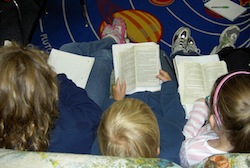Reading spaces in schools vary but even a school with a couple of small book corners probably has more to offer than the local corner shop. Yet it can be argued that local newsagents are often better at attracting children to their wares. With clear face-out magazine display children are instantly drawn to the group of titles aimed at them, enabling them to easily flick through a few before selecting their favourite. This easy selection process means it is an enjoyable part of the reading experience for these children.
In schools, we know we need to encourage children to select their own choice of reading material but we also need to make this as easy as possible for them. Face out display rather than spine-out display is by far the best way of attracting children. Publishers spend millions each year on designing the front covers, yet so often we turn them spine-out – losing an opportunity to attract children. Overstocking can also be a problem. With so many books to offer we fill every nook and cranny. But the problem then is that not only do we revert to spine-out display to stock as many as possible on the shelves but we also overwhelm children.
{googleAds}<script type="text/javascript"><!--
google_ad_client = "ca-pub-9940670887654728";
/* Expert Articles 468x60 */
google_ad_slot = "7545621260";
google_ad_width = 468;
google_ad_height = 60;
//-->
</script>
<script type="text/javascript"
src="http://pagead2.googlesyndication.com/pagead/show_ads.js">
</script>{/googleAds}
Selecting furniture which is designed specifically for children’s books is a good way of ensuring that books are made the stars of the show. If the furniture makes the books look irresistible then the children are in there straight away, reaching out and picking them up. On-shelf display solutions which have been designed to support the books as well as providing face-out display are perfect. They enhance shelving you already have so are a cost-effective solution which can dramatically change the look of your space. If you have the space and budget it might be worth investing in a centrepiece, something with a ‘wow’ factor. There are some wonderful units which, as well as displaying books add a play element (mirror tunnels, magnetic playboards, cosy seating). As well as being an instant attraction and drawing children into the reading space it also ensures children see books and reading as fun.
If you stock reading schemes such as Big Cats or Bug Club you’ll know what a nightmare they are to display on-shelf. Their slim format means that when displayed spine-on, they disappear! Using on-shelf display to store and display these titles can save time for pupils and teachers by providing acrylic pockets to hold collections of books together in a face-forward display.
As well as finding the right unit to hold the stock, it’s also important to think about where to place the unit. Think about the age of the young reader you’re trying to attract. Obviously picturebooks and board books need to be displayed lower down so that smaller children can reach them. Use the higher shelves for older children’s books. It doesn’t matter if you mix formats on a bay. The important thing is your borrowers can reach out and pick the books they want.
If you have the unit and the positioning right, the final thing to remember is to keep checking your displays. Keep them topped up at all times, otherwise it will look like the best has already gone and they’ve been ‘picked over’. But also, keep changing the books you display face-forward or at the front of the shelf. Bringing older titles forward for a turn in the spotlight occasionally will make it look like you have new stock. Remember children will find the latest Jacqueline Wilson or Anthony Horowitz because they know what they’re looking for but older titles need to be displayed front-of-stage sometimes to remind children what a good read they are. Don’t be afraid to experiment and have fun with your displays – it will show and your pupils will love it!


















